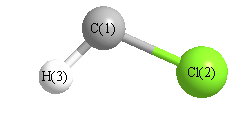Jump to
S2C1
Energy calculated at MP2/cc-pVDZ
| | hartrees |
|---|
| Energy at 0K | -498.074462 |
| Energy at 298.15K | -498.074339 |
| HF Energy | -497.826919 |
| Nuclear repulsion energy | 38.515638 |
The energy at 298.15K was derived from the energy at 0K
and an integrated heat capacity that used the calculated vibrational frequencies.
Geometric Data calculated at MP2/cc-pVDZ
Point Group is Cs
Cartesians (Å)
| Atom |
x (Å) |
y (Å) |
z (Å) |
|---|
| C1 |
0.046 |
1.199 |
0.000 |
| Cl2 |
0.046 |
-0.507 |
0.000 |
| H3 |
-1.053 |
1.427 |
0.000 |
Atom - Atom Distances (Å)
| |
C1 |
Cl2 |
H3 |
| C1 | | 1.7059 | 1.1219 |
Cl2 | 1.7059 | | 2.2246 | H3 | 1.1219 | 2.2246 | |
 More geometry information
More geometry information
Calculated Bond Angles
| atom1 |
atom2 |
atom3 |
angle |
|
atom1 |
atom2 |
atom3 |
angle |
| Cl2 |
C1 |
H3 |
101.761 |
|
Electronic energy levels
Charges, Dipole, Quadrupole and Polarizability
Jump to
S1C1
Energy calculated at MP2/cc-pVDZ
| | hartrees |
|---|
| Energy at 0K | -498.074308 |
| Energy at 298.15K | -498.074170 |
| HF Energy | -497.851441 |
| Nuclear repulsion energy | 38.605618 |
The energy at 298.15K was derived from the energy at 0K
and an integrated heat capacity that used the calculated vibrational frequencies.
Geometric Data calculated at MP2/cc-pVDZ
Point Group is Cs
Cartesians (Å)
| Atom |
x (Å) |
y (Å) |
z (Å) |
|---|
| C1 |
0.037 |
1.165 |
0.000 |
| Cl2 |
0.037 |
-0.517 |
0.000 |
| H3 |
-0.852 |
1.803 |
0.000 |
Atom - Atom Distances (Å)
| |
C1 |
Cl2 |
H3 |
| C1 | | 1.6823 | 1.0947 |
Cl2 | 1.6823 | | 2.4851 | H3 | 1.0947 | 2.4851 | |
 More geometry information
More geometry information
Calculated Bond Angles
| atom1 |
atom2 |
atom3 |
angle |
|
atom1 |
atom2 |
atom3 |
angle |
| Cl2 |
C1 |
H3 |
125.659 |
|
Electronic energy levels
Charges, Dipole, Quadrupole and Polarizability
